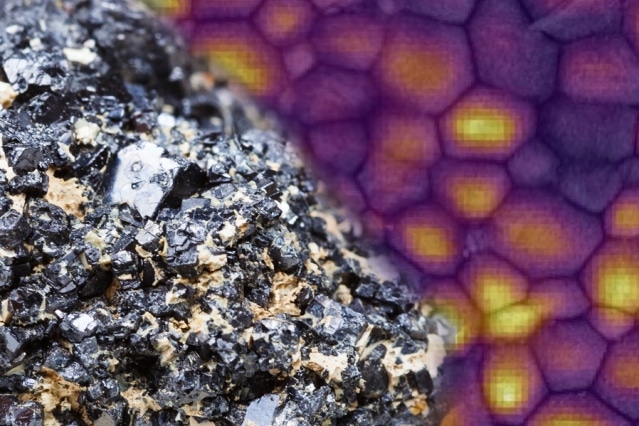May 25 2016
Perovskites are a group of compounds that can be made into thin films with many potential optical and electronic properties. In the past few years, these compounds have been a subject of intense research.
 A sample of the mineral perovskite is shown in the foreground, while behind it is an image the researchers used to prove the effects of intense light on a thin film of perovskite. Fluorescence imaging shows that areas that received more light became more purified, as revealed by brighter fluorescence from those regions. (Image: MIT News. Fluorescence image courtesy of the researchers)
A sample of the mineral perovskite is shown in the foreground, while behind it is an image the researchers used to prove the effects of intense light on a thin film of perovskite. Fluorescence imaging shows that areas that received more light became more purified, as revealed by brighter fluorescence from those regions. (Image: MIT News. Fluorescence image courtesy of the researchers)
Even though these materials could be potentially useful in applications like solar cells, certain drawbacks still hinder their consistency and efficiency.
Currently, a group of scientists at MIT and elsewhere say they have made remarkable inroads toward interpreting a method for enhancing perovskites’ performance by merely altering the material with a strong light. The new discoveries are being published in the Nature Communications journal, in a paper authored by Samuel Stranks, a researcher at MIT; Vladimir Bulović, the Fariborz Maseeh (1990) Professor of Emerging Technology and Associate Dean for innovation; and eight co-workers at other institutions in the U.K. and the U.S.
The study, headed by Stranks within MIT’s Organic and Nanostructured Electronics Laboratory, is part of a main research attempt on perovskite materials.
Minute flaws in the crystalline structure of perovskite can hinder the transformation of light into electricity in a solar cell, however “what we’re finding is that there are some defects that can be healed under light,” says Stranks, a Marie Curie Fellow jointly at MIT and Cambridge University in the U.K. The minute flaws, known as traps, could make electrons recombine with atoms much earlier than the electrons can arrive at a place within the crystal where their movement can be exploited.
Under strong illumination, it was discovered that iodide ions - atoms devoid of an electron to possess an electric charge - traveled away from the lighted region, and in the process apparently swept away most of the flaws in that place along with them.
This is the first time this has been shown, where just under illumination, where no [electric or magnetic] field has been applied, we see this ion migration that helps to clean the film. It reduces the defect density.
Samuel Stranks, Researcher, MIT
Although the effect had been noticed before, this study is the first to prove that the enhancement was due to the movement of ions caused by the illumination.
This study is aimed at specific types of the material, called organic-inorganic metal halide perovskites, which are thought to be promising for applications like lasers, LEDs, solar cells, and light detectors. They stand out in a property known as the photoluminescence quantum efficiency, which is important to increase solar cell efficiency. However, the performance of various batches of these materials, or diverse spots within the same film, has been unpredictable and highly changeable. The recent study was focused on understanding the cause of these discrepancies and how to decrease or prevent them.
Stranks elaborates that “the ultimate aim is to make defect-free films,” and the resultant enhancements in efficiency might also be helpful for light emission and light capture applications.
Earlier work decreasing flaws in thin-film perovskite materials has aimed at chemical or electrical treatments, but “we find we can do the same with light,” says Stranks. One benefit of that is that the same method used to improvise the properties of the material could be used as a sensitive probe to monitor and better interpret he behavior of these capable materials at the same time.
Yet another benefit of this light-based processing is that it does not need anything to come into physical contact with the film that is being treated - for instance, there is no requirement to join electrical contacts or to wash the material using a chemical solution. Alternatively, the treatment could just be functional by switching on the source of illumination. The process called photo-induced cleaning, might be “a way forward” towards the advancement of valuable perovskite-based devices, says Stranks.
The consequences of the illumination are likely to lessen over time, Stranks says, so “the challenge now is to maintain the effect” up to the duration to make it realistic. Certain types of perovskites are already “looking to be commercialized by next year,” he says, and this study “raises questions that need to be addressed, but it also shows there are ways to address” the phenomena that have been restricting the performance of this material.
I think the paper provides valuable insight that is likely to help people make more efficient solar cells by figuring out how to reduce the number of iodine vacancies. I think it is fascinating that illuminating the perovskites improves their photoluminescence efficiency by enabling iodine to move around and eliminate iodine vacancies. This research does not make solar cells better, but it does greatly increase our understanding of how these complex materials function in solar cells.
Michael McGehee, Professor of Materials Science and Engineering at Stanford University
Apart from Stranks and Bulović, the group included Anna Osherov from MIT, Dane deQuilettes, Daniel Graham, and David Ginger from the University of Washington, and Wei Zhang, Victor Burlakov, Tomas Leitjens, and Henry Snaith from Oxford University in the U.K.
The study was financed by the European Union Seventh Framework Programme, the U.S. National Science Foundation, the Center for Excitonics, an Energy Frontier Research Center at MIT funded by the U.S. Department of Energy, and the National Institutes of Health supported this project.